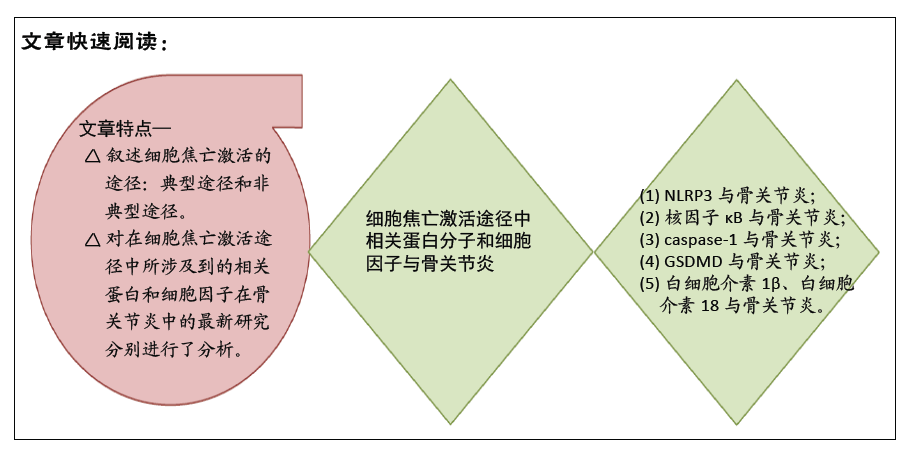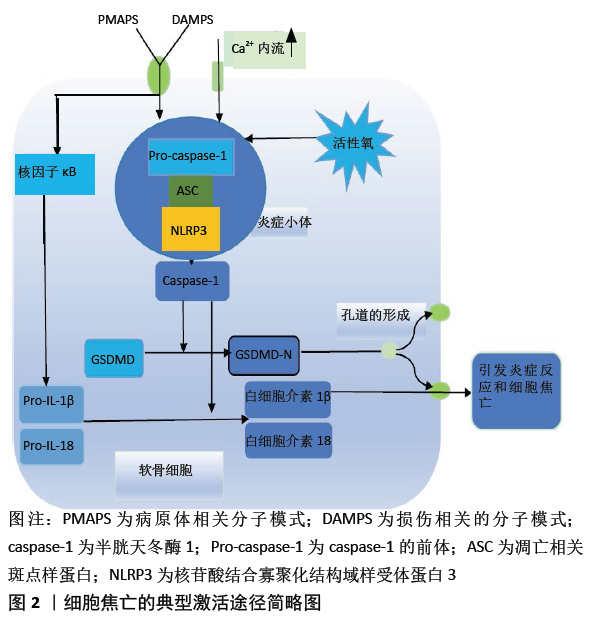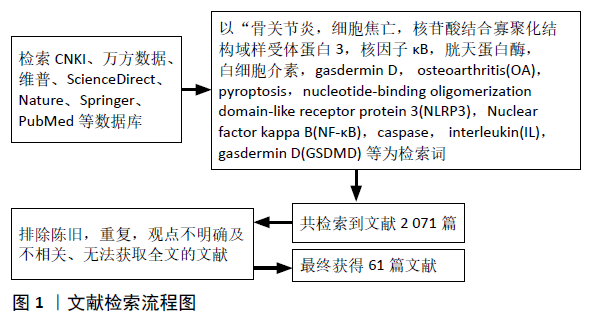[1] BOWDEN JL, HUNTER DJ, DEVEZA LA, et al. Core and adjunctive interventions for osteoarthritis: efficacy and models for implementation. Nat Rev Rheumatol. 2020;16(8):434-447.
[2] PRIMORAC D, MOLNAR V, ROD E, et al. Knee Osteoarthritis: A Review of Pathogenesis and State-Of-The-Art Non-Operative Therapeutic Considerations. Genes (Basel). 2020;11(8):854.
[3] 付长龙,叶锦霞,林洁,等.新型程序性细胞死亡对骨关节炎软骨基质稳态影响之初探[J].风湿病与关节炎,2020,9(5):55-57+80.
[4] LIM Y, KUMAR S. A single cut to pyroptosis. Oncotarget. 2015;6(35): 36926-36927
[5] LU F, LAN Z, XIN Z, et al. Emerging insights into molecular mechanisms underlying pyroptosis and functions of inflammasomes in diseases. J Cell Physiol. 2020;235(4):3207-3221.
[6] XU YJ, ZHENG L, HU YW, et al. Pyroptosis and its relationship to atherosclerosis. Clin Chim Acta. 2018;476:28-37.
[7] TSUCHIYA K. Inflammasome-associated cell death: Pyroptosis, apoptosis, and physiological implications. Microbiol Immunol. 2020; 64(4):252-269.
[8] JIA C, CHEN H, ZHANG J, et al. Role of pyroptosis in cardiovascular diseases. Int Immunopharmacol. 2019;67:311-318.
[9] MENU P, VINCE JE. The NLRP3 inflammasome in health and disease: the good, the bad and the ugly. Clin Exp Immunol. 2011;166(1):1-15.
[10] LI W, CAO T, LUO C, et al. Crosstalk between ER stress, NLRP3 inflammasome, and inflammation. Appl Microbiol Biotechnol. 2020; 104(14):6129-6140.
[11] HACHIM MY, KHALIL BA, ELEMAM NM, et al. Pyroptosis: The missing puzzle among innate and adaptive immunity crosstalk. J Leukoc Biol. 2020;108(1):323-338.
[12] LIANG F, ZHANG F, ZHANG L, et al. The advances in pyroptosis initiated by inflammasome in inflammatory and immune diseases. Inflamm Res. 2020;69(2):159-166.
[13] MEYERS AK, ZHU X. The NLRP3 Inflammasome: Metabolic Regulation and Contribution to Inflammaging. Cells. 2020;9(8):1808.
[14] ZENG C, WANG R, TAN H. Role of Pyroptosis in Cardiovascular Diseases and its Therapeutic Implications. Int J Biol Sci. 2019;15(7):1345-1357.
[15] ZHENG Z, LI G. Mechanisms and Therapeutic Regulation of Pyroptosis in Inflammatory Diseases and Cancer. Int J Mol Sci. 2020;21(4):1456.
[16] MATHUR A, HAYWARD JA, MAN SM. Molecular mechanisms of inflammasome signaling. J Leukoc Biol. 2018;103(2):233-257.
[17] SHI J, GAO W, SHAO F. Pyroptosis: Gasdermin-Mediated Programmed Necrotic Cell Death. Trends Biochem Sci. 2017;42(4):245-254.
[18] ROGERS C, FERNANDES-ALNEMRI T, MAYES L, et al. Cleavage of DFNA5 by caspase-3 during apoptosis mediates progression to secondary necrotic/pyroptotic cell death. Nat Commun. 2017;8:14128.
[19] ZHOU B, ZHANG JY, LIU XS, et al. Tom20 senses iron-activated ROS signaling to promote melanoma cell pyroptosis. Cell Res. 2018;28(12): 1171-1185.
[20] SURI S, WALSH DA. Osteochondral alterations in osteoarthritis. Bone. 2012;51(2):204-211.
[21] CHEN D, SHEN J, ZHAO W, et al. Osteoarthritis: toward a comprehensive understanding of pathological mechanism. Bone Res. 2017;5:16044.
[22] LIU Q, WU Z, HU D, et al. Low dose of indomethacin and Hedgehog signaling inhibitor administration synergistically attenuates cartilage damage in osteoarthritis by controlling chondrocytes pyroptosis. Gene. 2019;712:143959.
[23] HAN D, FANG Y, TAN X, et al. The emerging role of fibroblast-like synoviocytes-mediated synovitis in osteoarthritis: An update.J Cell Mol Med. 2020;24(17):9518-9532.
[24] ZHANG L, ZHANG L, HUANG Z, et al. Increased HIF-1α in Knee Osteoarthritis Aggravate Synovial Fibrosis via Fibroblast-Like Synoviocyte Pyroptosis.Oxid Med Cell Longev. 2019;2019:6326517.
[25] ABAIS JM, XIA M, ZHANG Y, et al. Redox regulation of NLRP3 inflammasomes: ROS as trigger or effector? Antioxid Redox Signal. 2015;22(13):1111-1129.
[26] ZHOU J, ZHAO Y, WU G, et al. Differential miRNAomics of the synovial membrane in knee osteoarthritis induced by bilateral anterior cruciate ligament transection in rats. Mol Med Rep. 2018;18(4):4051-4057.
[27] MCALLISTER MJ, CHEMALY M, EAKIN AJ, et al. NLRP3 as a potentially novel biomarker for the management of osteoarthritis. Osteoarthritis Cartilage. 2018;26(5):612-619.
[28] SCANZELLO CR, GOLDRING SR. The role of synovitis in osteoarthritis pathogenesis. Bone. 2012;51(2):249-257.
[29] MENDEZ ME, SEBASTIAN A, MURUGESH DK, et al. LPS-Induced Inflammation Prior to Injury Exacerbates the Development of Post-Traumatic Osteoarthritis in Mice. J Bone Miner Res. 2020;35(11): 2229-2241.
[30] ZHAO LR, XING RL, WANG PM, et al. NLRP1 and NLRP3 inflammasomes mediate LPS/ATP‑induced pyroptosis in knee osteoarthritis. Mol Med Rep.2018;17(4):5463-5469.
[31] ZU Y, MU Y, LI Q, et al. Icariin alleviates osteoarthritis by inhibiting NLRP3-mediated pyroptosis. J Orthop Surg Res. 2019;14(1):307.
[32] WANG Y, LIU X, SHI H, et al. NLRP3 inflammasome, an immune-inflammatory target in pathogenesis and treatment of cardiovascular diseases. Clin Transl Med. 2020;10(1):91-106.
[33] FORT BP, DUBYAK GR, GREENFIELD EM. Lysosomal disruption by orthopedic wear particles induces activation of the NLRP3 inflammasome and macrophage cell death by distinct mechanisms. J Orthop Res. 2021;39(3):493-505.
[34] LI JP, WEI W, LI XX, et al. Regulation of NLRP3 inflammasome by CD38 through cADPR-mediated Ca2+ release in vascular smooth muscle cells in diabetic mice. Life Sci. 2020;255:117758.
[35] CHEN Z, ZHONG H, WEI J, et al. Inhibition of Nrf2/HO-1 signaling leads to increased activation of the NLRP3 inflammasome in osteoarthritis. Arthritis Res Ther. 2019;21(1):300.
[36] JIMI E, FEI H, NAKATOMI C. NF-κB Signaling Regulates Physiological and Pathological Chondrogenesis. Int J Mol Sci. 2019;20(24):6275.
[37] SCHRODER K, TSCHOPP J. The inflammasomes. Cell. 2010;140(6):821-32.
[38] GUO H, CALLAWAY JB, TING JP. Inflammasomes: mechanism of action, role in disease, and therapeutics. Nat Med. 2015;21(7):677-687.
[39] RIGOGLOU S, PAPAVASSILIOU AG. The NF-κB signalling pathway in osteoarthritis. Int J Biochem Cell Biol. 2013;45(11):2580-2584
[40] CHOI MC, JO J, PARK J, et al. NF-κB Signaling Pathways in Osteoarthritic Cartilage Destruction. Cells. 2019;8(7):734.
[41] HU J, ZHOU J, WU J, et al. Loganin ameliorates cartilage degeneration and osteoarthritis development in an osteoarthritis mouse model through inhibition of NF-κB activity and pyroptosis in chondrocytes.J Ethnopharmacol. 2020;247:112261.
[42] MIAO EA, RAJAN JV, ADEREM A. Caspase-1-induced pyroptotic cell death. Immunol Rev. 2011;243(1):206-214.
[43] ZHANG L, XING R, HUANG Z, et al. Inhibition of Synovial Macrophage Pyroptosis Alleviates Synovitis and Fibrosis in Knee Osteoarthritis.Mediators Inflamm. 2019;2019:2165918.
[44] MULVIHILL E, SBORGI L, MARI SA, et al. Mechanism of membrane pore formation by human gasdermin-D. EMBO J. 2018;37(14):e98321.
[45] AGLIETTI RA, DUEBER EC. Recent Insights into the Molecular Mechanisms Underlying Pyroptosis and Gasdermin Family Functions. Trends Immunol. 2017;38(4):261-271.
[46] DE VASCONCELOS NM, VAN OPDENBOSCH N, VAN GORP H, et al. Single-cell analysis of pyroptosis dynamics reveals conserved GSDMD-mediated subcellular events that precede plasma membrane rupture.Cell Death Differ. 2019;26(1):146-161.
[47] 徐波. 滑膜巨噬细胞焦亡激活膝骨关节炎痛敏及“易层”贴敷的干预机制 [D]. 南京:南京中医药大学,2020.
[48] VINCENT TL. IL-1 in osteoarthritis: time for a critical review of the literature. F1000Res. 2019;8:F1000 Faculty Rev-934.
[49] MIGLIORINI P, ITALIANI P, PRATESI F, et al. The IL-1 family cytokines and receptors in autoimmune diseases. Autoimmun Rev. 2020;19(9):102617.
[50] SUN Y, WANG C, GONG C. Repairing effects of glucosamine sulfate in combination with etoricoxib on articular cartilages of patients with knee osteoarthritis. J Orthop Surg Res. 2020;15(1):150.
[51] KAPOOR M, MARTEL-PELLETIER J, LAJEUNESSE D, et al. Role of proinflammatory cytokines in the pathophysiology of osteoarthritis. Nat Rev Rheumatol. 2011;7(1):33-42.
[52] YANG S, KIM J, RYU JH, et al. Hypoxia-inducible factor-2alpha is a catabolic regulator of osteoarthritic cartilage destruction. Nat Med. 2010;16(6):687-693.
[53] CHAGANTI RK, PURDUE E, SCULCO TP, et al. Elevation of serum tumor necrosis factor α in patients with periprosthetic osteolysis: a case-control study. Clin Orthop Relat Res. 2014;472(2):584-589.
[54] ANSARI MY, AHMAD N, HAQQI TM. Oxidative stress and inflammation in osteoarthritis pathogenesis: Role of polyphenols. Biomed Pharmacother. 2020;129:110452.
[55] LIU R, WU H, SONG H. Knockdown of TRIM8 Attenuates IL-1β-induced Inflammatory Response in Osteoarthritis Chondrocytes Through the Inactivation of NF-κB Pathway. Cell Transplant. 2020;29:963689720943604.
[56] VECCHIÉ A, BONAVENTURA A, TOLDO S, et al. IL-18 and infections: Is there a role for targeted therapies. J Cell Physiol. 2021;236(3): 1638-1657.
[57] BAO J, CHEN Z, XU L, et al. Rapamycin protects chondrocytes against IL-18-induced apoptosis and ameliorates rat osteoarthritis. Aging (Albany NY). 2020;12(6):5152-5167.
[58] PENG CZ, CAO JM, XIAO T, et al. Concentration of IL-18 and PGE2 in synovial fluid in patients with osteoarthritis and its significance. Zhong Nan Da Xue Xue Bao Yi Xue Ban. 2006;31(6):862-865.
[59] JIAO Y, WANG L, LU L, et al.The Role of Caspase-4 and NLRP1 in MCF7 Cell Pyroptosis Induced by hUCMSC-Secreted Factors. Stem Cells Int. 2020;2020:8867115.
[60] FAN C, ZHAO X, GUO X, et al. P2X4 promotes interleukin‑1β production in osteoarthritis via NLRP1. Mol Med Rep. 2014;9(1):340-344.
[61] WU Y, WANG Z, LIN Z, et al. Salvianolic Acid A Has Anti-Osteoarthritis Effect In Vitro and In Vivo. Front Pharmacol. 2020;11:682.
|



